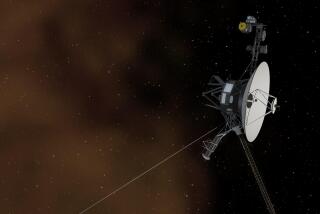Mars Reconnaissance Orbiter switches brains after computer glitch
NASA’s elderly Mars Reconnaissance Orbiter flipped into “safe mode” on Sunday after an unexpected computing glitch caused the spacecraft to switch from its main computer to its backup.
The 8-year-old satellite, which left Earth in August 2005 and entered Martian orbit on March 10, 2006, has lived well beyond its primary two-year science phase, so perhaps the occasional “brain fart” is understandable. Tasked with searching for signs that water flowed on Mars for a long period of time, it’s been sending Earth detailed information about seasonal and longer-term changes on our rust-hued neighbor. In fact, it has returned more data than all other interplanetary missions combined, according to officials at the Jet Propulsion Laboratory in La Cañada Flintridge, which manages the mission.
The orbiter had been forced four times before to switch to the backup computer -- most recently in November 2011. Current Red Planet explorers are typically equipped with these “backup brains” so that the spacecraft can keep running while engineers work on fixing the main computer, a design that has already come in handy for the Mars rover Curiosity.
The Mars Reconnaissance Orbiter, along with NASA’s Odyssey satellite (launched in 2001), is one of two main communication lines between Earth and NASA’s two rovers: Curiosity and its long-lived 2004 predecessor, Opportunity. No matter how much data the robotic explorers collect, they rely on the satellites’ long-distance lines to send it home. So any notable problems with the orbiters are potentially worrisome.
Fortunately, Mars Atmosphere and Volatile Evolution mission (or MAVEN for short) is headed for the Red Planet now, scheduled to enter the Red Planet’s orbit in September. The spacecraft’s mission will be to find out how and why Mars’s once-thick atmosphere vanished -- an atmosphere that could have supported liquid water long enough for life to develop and thrive.
But it will also serve as a backup to relay Curiosity and Opportunity’s field notes home, in case something happens to MRO or Odyssey.
In fact, the ability to catch the rovers’ data and lob it millions of miles back to Earth, just as MRO and Odyssey do, was what allowed MAVEN to escape last year’s ultimately short-lived government shutdown in October, which threatened to ground the spacecraft just before its Nov. 18 launch.
ALSO:
Meet RoboClam, a digging robot inspired by the razor clam
Kepler’s comeback? New K2 mission could chase wilder targets







